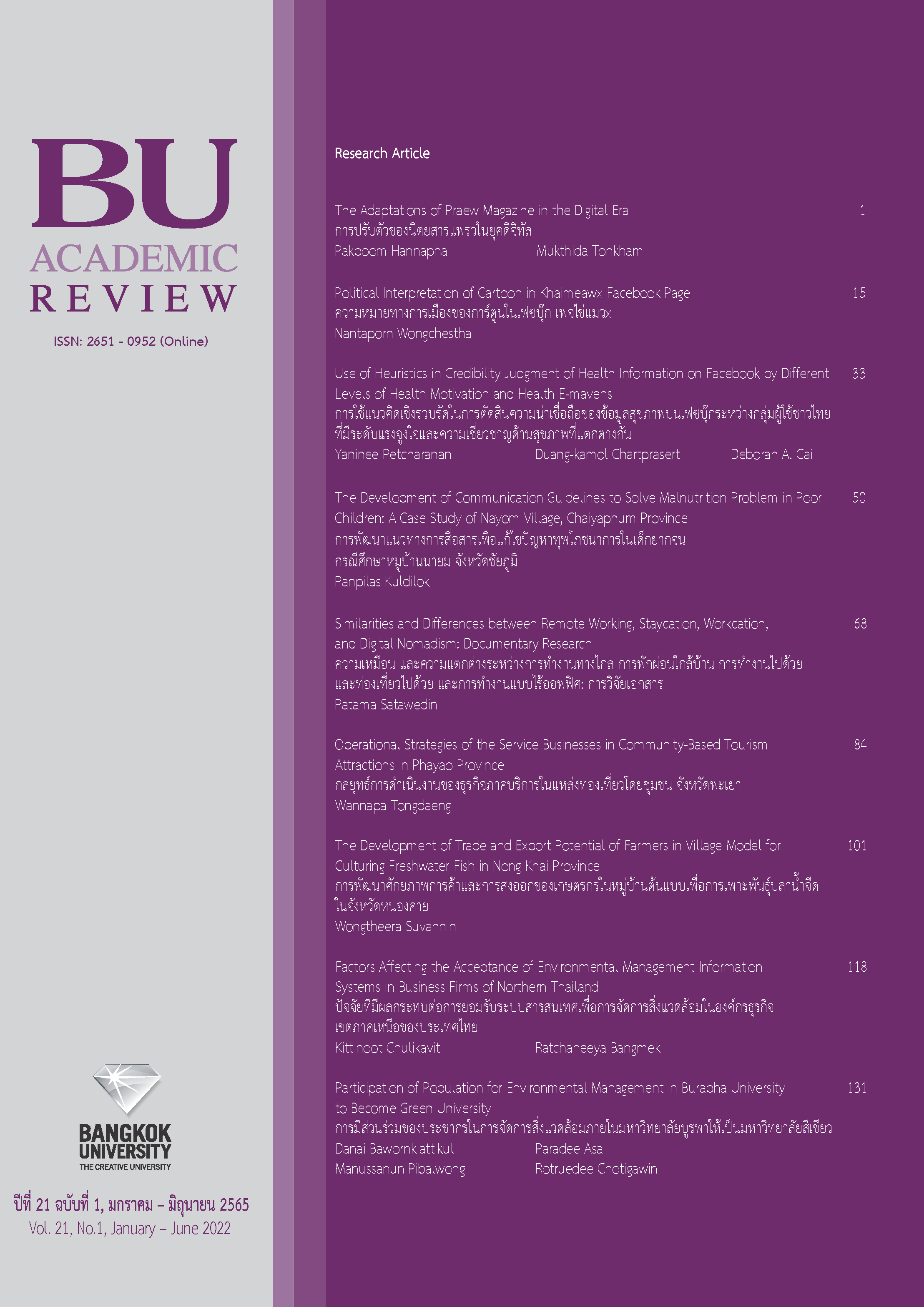ความหมายทางการเมืองของการ์ตูนในเฟซบุ๊ก เพจไข่แมวx
Main Article Content
บทคัดย่อ
บทความนี้เป็นส่วนหนึ่งของงานวิจัยเรื่อง ความหมายทางการเมืองของการ์ตูนในเฟซบุ๊ก เพจไข่แมวx ซึ่งเป็นเฟซบุ๊ก เพจที่มีจุดยืนตรงข้ามคณะรักษาความสงบแห่งชาติ (คสช.) จึงมุ่งวิพากษ์วิจารณ์ คสช. และรัฐบาลที่สืบทอดอำนาจจาก คสช. ผ่านการใช้การ์ตูน ภายใต้ภาวะการจำกัดสิทธิเสรีภาพในการแสดงออกทางการเมือง การวิจัยครั้งนี้มีวัตถุประสงค์เพื่อศึกษาความหมายทางการเมืองและรูปแบบสัญญัติที่ใช้ในการสื่อความหมายของการ์ตูนการเมือง ระหว่าง 16 กุมภาพันธ์ พ.ศ. 2561 – 12 มกราคม พ.ศ. 2563 เป็นการวิจัยเชิงคุณภาพ ใช้การวิเคราะห์ตัวบท และแนวคิดสัญญัติศาสตร์[1] ของ Charles Sander Peirce เพื่อหาความหมายทางการเมืองจากสัญญัติในการ์ตูน ผลการวิจัยพบความหมายทางการเมือง ผ่านตัวละครทางการเมืองหลัก และบริบททางการเมืองของประเทศไทยหรือกะลาแลนด์ โดยตัวละครกลุ่ม คสช. โดยเฉพาะหัวหน้า คสช. มีความหมายเชิงลบผ่านสัญญัติเพื่อลดทอนความน่าเชื่อถือ ขณะที่กลุ่มประชาธิปไตยมีความหมายเชิงบวก ความหมายทางการเมืองสะท้อนรัฐบาลอำนาจนิยมที่มุ่งจำกัดสิทธิเสรีภาพในการแสดงออกทางการเมือง การแทรกแซงการทำหน้าที่ของสื่อมวลชนและองค์กรอิสระ การบริหารประเทศอย่างไม่มีประสิทธิผล การเลื่อนเลือกตั้ง แม้เมื่อเลือกตั้งแล้วประเทศยังมีรัฐบาลที่สืบทอดอำนาจ คสช. การให้โทษฝ่ายตรงข้ามรัฐบาล รวมถึงพรรคการเมือง/นักการเมืองแก่งแย่งชิงประโยชน์ รูปแบบสัญญัติที่นำเสนอส่วนใหญ่ใช้ปฏิมาซึ่งคล้ายคลึงกับความจริงแม้เป็นภาพล้อแบบเกินจริงทำให้เข้าใจความหมายได้ง่าย แต่ที่โดดเด่นคือการสื่อความหมายโดยนัยผ่านสัญลักษณ์วัฒนธรรมประชานิยมที่ผู้ติดตามรู้จักและเข้าใจความหมายเป็นอย่างดี จึงเป็นกลวิธีลัดขั้นตอนการสร้างความหมายทางการเมืองที่ซับซ้อนอย่างชาญฉลาด และปรากฏดัชนีไม่มากนัก สัญญัติถูกใช้สื่อความหมายโดยนัยเพื่อแยกฝ่ายการเมือง ดำเนินเรื่อง และแสดงพฤติกรรมทางการเมืองพร้อมการล้อเลียน/เสียดสี ทำให้การ์ตูนของไข่แมวx สามารถเสนอความหมายทางการเมืองที่ซับซ้อนแต่กระชับ มีเอกลักษณ์ ดึงดูดใจผู้ติดตาม อีกทั้งหลบเลี่ยงจากถูกตรวจสอบเนื้อหาทางการเมืองของรัฐได้
[1] งานวิจัยใช้คำว่าสัญญัติศาสตร์ (semiotics) และสัญญัติ (sign) ซึ่งหมายถึงเครื่องหมาย ตามศัพท์ในตำราชื่อสารกับการสื่อความหมายของ Sotanasathien (2020)
Article Details

อนุญาตภายใต้เงื่อนไข Creative Commons Attribution-NonCommercial-NoDerivatives 4.0 International License.
บทความที่นำมาสมัครลงตีพิมพ์ในวารสารต้องไม่เคยได้รับการตีพิมพ์เผยแพร่มาก่อน และไม่ส่งต้นฉบับบทความซ้ำซ้อนกับวารสารอื่น รวมทั้งผู้เขียนบทความต้องไม่ละเมิดหรือคัดลอกผลงานของผู้อื่น
เอกสารอ้างอิง
Al-Momani, K., Badarneh, M. A., & Migdadi, F. A. (2017). A semiotic analysis of political cartoons in Jordan
in light of the Arab spring. The Journal of Humor, 30(1), 63-95.
BBC News. (2018, May 3). Sām samākhom sư̄ rīakrō̜ng hai yoklœ̄k khamsang khō̜sō̜chō̜ khum sư̄ sām chabap [The media association calls for NCPO orders controlling the media cancellation]. Retrieved August 13, 2020, from https://www.bbc.com/thai/thailand-43986594
Brand Buffet. (2018, November 9). Happy endings nithatsakān kātūn talok rāi čhāk sinlapin Joan Cornell
pǣt พ.ย. sām ธ.ค. nī [ Happy endings, the satirical cartoon exhibition from Joan Cornellà, Nov. 8 -
Dec. 3]. Retrieved August 13, 2020, from https://www.brandbuffet.in.th/ 2018/ 11/happy-endings- joan-cornella/
Chandler, D. (2017). Semiotics: The asics (3rd ed.). Oxon: Routledge.
Danesi, M. (2004). Message, signs, and meaning: A basic textbook in semiotics and communication theory.
Ontario: Canedian Scholars’ Press Inc.
Dugalich, N. M. (2018). Political cartoon as a genre of political discourse. RUDN Journal of Language Studies,
Semiotics and Semantics, 9(1), 158-172. DOI: 10.22363/2323-2299-2018-9-1-158-172
Freedman A., & Slade, T. (2018). Introducing Japanese popular culture. New York, NY: Routledge.
History Teaching Institute. (n.d.). Editorial cartoons: An introduction. Retrieved August 13, 2020, from
https://hti.osu.edu/opper/editorial-cartoons-introduction
iLaw. (2014). The report on online media suspension after the 22 May 2014 coup d’etat. Retrieved August
, 2020, from http://freedom.ilaw.or.th/node/131
Ismail, B. (n.d.). Prathēt Thai: Phonkrathop khō̜ng ratthaprahān pī sō̜ngphanhārō̜ihāsipčhet tō̜
sư̄muanchon [Media hounded by junta since 2014 coup]. Retrieved August 13, 2020, from https://rsf.org/sites/default/files/ rapport_thailande_th-2.pdf
Jakobson, R. (1977). A few remarks on Peirce, pathfinder in the science of language. Comparative Literature,
(5), 1026 - 1032. https://doi.org/2906890
Kawwathanasakula, J. (1992). Kātūn kānmư̄ang nai yuk ratthabān phadetkān : sưksā chapho̜ kātūn
kānmư̄ang chūang rawāng yīsipsām Kumphāphan kao Thanwākhom sō̜ngphanhārō̜isāmsipsī
[Political cartoons during the dictatorship government: The study of political cartoons from February 23, 1991 to December 9, 1991] (Master’s thesis, Chiang Mai University).
Khaimeawx. (2018). Khai mǣo x [cartooneggcatx]. Retrieved August 13, 2020, from https://www.facebook.com/cartooneggcatx
Khaimeawx. (2019). Khai mǣo x [cartooneggcatx]. Retrieved August 13, 2020, from https://www.facebook.com/cartooneggcatx
Khaimeawx. (2020). Khai mǣo x [cartooneggcatx]. Retrieved August 13, 2020, from https://www.facebook.com/cartooneggcatx
Klampaiboon, S. (2018). Khai mǣo ngān sinlapa thī yūalō̜ phadetkān nai yām thī khrai khrai kō̜ sensœ̄ tūa
ʻēng [Khaimeaw, the art that teases a dictator when everyone censors themselves]. Retrieved August 13, 2020, from https://themomentum.co/cartooneggcatx-overview-by-sirote/
Marin-Arrese, J. I. (2019). Political cartoon discourse: Creativity, critique and persuasion. Cultural Studies
Journal of Universitat Jaume I, 22(2019), 117-134.
Ngamlue, S. (2016). Kānsưksā wikhro̜ phāp lō̜ sangkhom Thai nai sư̄ sangkhom ʻō̜nlai [An analytical study
of the Thai caricature in the social media]. KKU International Journal of Humanities and Social Sciences, 6(1), 50-79.
Pangpun, S. (2001). Kānprakō̜p sāng læ kān sư̄ khwāmmāi khō̜ng kātūn kānmư̄ang Thai nai chūang
ronnarong kānlư̄ak tang thūapai Phō̜.Sō̜. 2544 [The construction and signification of mass media
political comics prior general election campaigning 2001] (Master’s thesis, Chulalongkorn
University).
Permana, Y. R. (2019). Analysis of political cartoon in Jakarta post e-paper. Journal of Languages and
Language Teaching, 7(1), 6-20.
Prendergast, M. (2019). Political cartoons as carnivalesque: A multimodal discourse analysis of Argentina’s
Humor Registrado magazine. Social Semiotics, 29(1), 45-67. https://doi.org/10.1080/10350330.2017.1406587.
Rodpai, R. (1998). Kān wikhro̜ nư̄ahā kātūn lō̜ kānmư̄ang nai nangsư̄phim rāi wan chabap phāsā Thai sām
chabap nai chūang kānbō̜rihān ngān khō̜ng phon ʻēk chawalit yong čhai yut nāyokratthamontrī khonthī yīsipsō̜ng khō̜ng Thai [Content analysis of political cartoons in 3Thai daily newspapers during the administration of general Chavalit Yongchaiyudh, the 22nd Prime Minister of Thailand] (Master’s thesis, Thammasat University).
Royal Institute. (2013). Photčhanānukrom chabap rātchabanthittayasathān Phō̜.Sō̜.
sō̜ngphanhārō̜ihāsipsī chalœ̄m phrakīanti phra bāt somdet phračhaoyūhūa nư̄ang nai ʻōkāt
phra rāt phithī mahā mongkhon chalœ̄m phrachonmaphansā čhet rō̜p hā Thanwākhom
sō̜ngphanhārō̜ihāsipsī [The Royal Academy Dictionary, 2011, Honorable Mention His Majesty On
the occasion of the auspicious ceremony Celebrating the 7th Cycle Birthday Anniversary, 5
December 2011] Bangkok: The Royal Institute.
Rungnarong, N. (1990). Kātūn kānmư̄ang nai chūang sipsī Tulākhom sō̜ngphanhārō̜isiphok thưng hok
Tulākhom sō̜ngphanhārō̜isipkāo [Political cartoon (October 4, 1973 – October 6, 1976]
(Master’s thesis, Chulalongkorn University).
Sotanasathien, S. (2020). Sān kap kān sư̄ khwāmmāi (Phim khrang thī sō̜ng) [Message and meaning (2nd
ed.)]. Bangkok: Chamchuri Product.
Soukhanov, A. (1999). Encarta world english dictionary [North American edition]. New York: St Martins
Press.
Storey, J. (2018). Cultural theory and popular culture: An introduction (8th ed.). London: Routledge.
Tanyapaibul, T. (1998). Kān wikhro̜ krabūankān pratū khāosān kātūn kānmư̄ang nai nangsư̄phim rāi wan
phāsā Thai [An analysis of gatekeeping process of political cartoons in Thai daily newspapers] (Master’s thesis, Chiang Mai University).
Teeravutchuvong, P. (1999). Kān sư̄ khwāmmāi čhāk praden thāngkān mư̄ang phān kātūn kānmư̄ang [The
conveying of meaning on political issues through political cartoons/Piengrhudee] (Master’s thesis, Chulalongkorn University).
Thaipublica. (2014, August 4). คสช. ʻāng mai dai sang pit fētbuk khana thī lāi fāi yư̄nyan dai rapkham
sang čhing [NCPO - claims that it has not ordered the closure of the Facebook]. Retrieved August 13, 2020, from https://.org/jabted_issue/
Thrakulphiw, J. (2020). Kān lō̜līan nai phētfētbuk praphēt sīatsī kānmư̄ang [Parody of political satire on
Facebook page] (Master’s independent study, Chiang Mai University).
Wongchestha, N. (2017). Kānsư̄sān khō̜ng kān tōyǣng kānmư̄ang phāk prachāchon nai prathēt Thai
rawāng sāmsip Tulākhom Phō̜.Sō̜. sō̜ngphanhārō̜ihāsiphok yīsipsō̜ng Phrưtsaphākhom Phō̜.Sō̜. sō̜ngphanhārō̜ihāsipčhet [Political communication for civil’s contentious in Thailand during October 30, 2013 - May 22, 2014]. Pathumthani: Faculty of Journalism and Mass Communication, Thammasat University).
World Affairs Council. (n.d.). Understanding the world of political cartoons. Retrieved August 13, 2020, from
http://hhssocialstudies30.weebly.com/uploads/5/1/9/2/5192923/understanding_the_world_
of_political_cartoons.pdf


